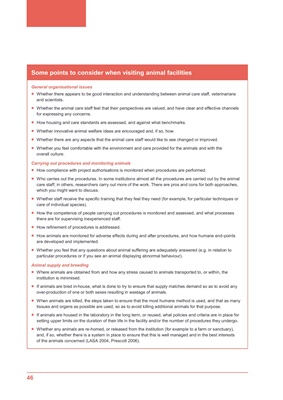
46
Some points to consider when visiting animal facilities
General organisational issues
Whether there appears to be good interaction and understanding between animal care staff, veterinarians
and scientists.
Whether the animal care staff feel that their perspectives are valued, and have clear and effective channels
for expressing any concerns.
How housing and care standards are assessed, and against what benchmarks.
Whether innovative animal welfare ideas are encouraged and, if so, how.
Whether there are any aspects that the animal care staff would like to see changed or improved.
Whether you feel comfortable with the environment and care provided for the animals and with the
overall culture.
Carrying out procedures and monitoring animals
How compliance with project authorisations is monitored when procedures are performed.
Who carries out the procedures. In some institutions almost all the procedures are carried out by the animal
care staff; in others, researchers carry out more of the work. There are pros and cons for both approaches,
which you might want to discuss.
Whether staff receive the specific training that they feel they need (for example, for particular techniques or
care of individual species).
How the competence of people carrying out procedures is monitored and assessed, and what processes
there are for supervising inexperienced staff.
How refinement of procedures is addressed.
How animals are monitored for adverse effects during and after procedures, and how humane end-points
are developed and implemented.
Whether you feel that any questions about animal suffering are adequately answered (e.g. in relation to
particular procedures or if you see an animal displaying abnormal behaviour).
Animal supply and breeding
Where animals are obtained from and how any stress caused to animals transported to, or within, the
institution is minimised.
If animals are bred in-house, what is done to try to ensure that supply matches demand so as to avoid any
over-production of one or both sexes resulting in wastage of animals.
When animals are killed, the steps taken to ensure that the most humane method is used, and that as many
tissues and organs as possible are used, so as to avoid killing additional animals for that purpose.
If animals are housed in the laboratory in the long term, or reused, what policies and criteria are in place for
setting upper limits on the duration of their life in the facility and/or the number of procedures they undergo.
Whether any animals are re-homed, or released from the institution (for example to a farm or sanctuary),
and, if so, whether there is a system in place to ensure that this is well managed and in the best interests
of the animals concerned (LASA 2004, Prescott 2006).